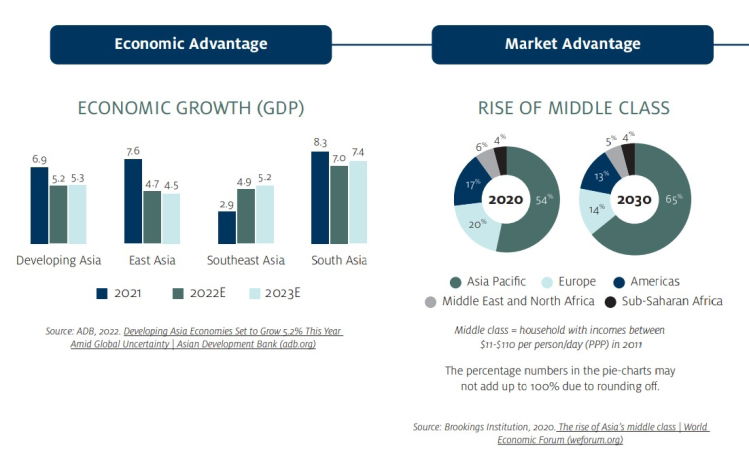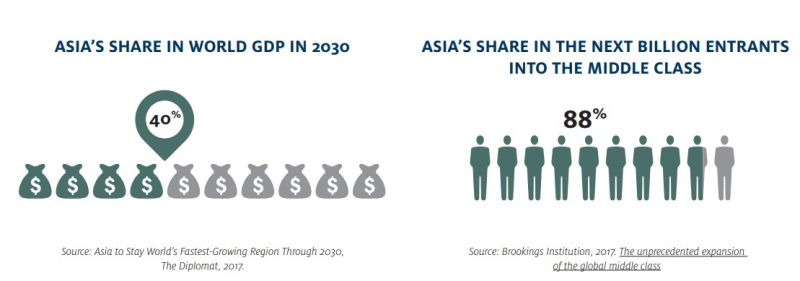share on
Among the top 200 organisations surveyed, Asians comprised just 4% of executive teams in US-headquartered companies in 2022, a decline from 8% in 2017.
According to Center for Creative Leadership (CCL)'s Global Asian leader: From Asia, for the world report, developing Asia economies are projected to grow 5.2% in 2023 despite global uncertainties.
As suggested in the report, this would further call upon local leaders with a nuanced understanding of social and cultural norms to drive regional expansion.
Asia cited as the centre of the world, but bamboo ceiling endures
Despite the pandemic, Asia is growing at a more rapid pace compared to the rest of the world, offers the largest market, is a potential catchment area for talent, and is a hotbed for innovation and entrepreneurship.
According to the Asian Development Bank, East Asia is on course for expansions of 4.7% and 4.5%, respectively in 2022 and 2023. Meanwhile, Southeast Asia is expected to hit 4.9% growth in 2022 and 5.2% the year after, with South Asian economies forecasted to grow 7.0% and 7.4% over the same period. The bank expects several subregions, including South Asia and East Asia, to return to pre-pandemic economic growth rates.
Additionally, data pegs Asia’s share in the world GDP at 40% in 2030.


To override cultural hardwiring and succeed in global roles, the study identified five important traits that Asian leaders must demonstrate – courage, curiosity, trust, an ability to influence decisions, and strategic thinking. Asian leaders, it was highlighted, have made notable progress in all these areas over the past five years — for example, strategic thinking was one area that noted significant improvement, scoring 3.82, an increase from 3.74 in 2017.
Yet, even with the strong business case to develop Asian leaders, Asian representation in top leadership has fallen since 2017. Among the top 200 organisations studied, Asians comprised only 4% of executive teams in US-headquartered companies in 2022, a decline from 8% in 2017.
Meanwhile, Europe-headquartered firms noted only 3% Asian representation. This data climbs marginally for the top 500 firms, the study further noted.
"Talent in Asia has developed tremendously across multiple leadership attributes over the last decade – however our latest research reveals an alarming trend over the last few years of decreasing representation of Asian leaders in top multi-national teams. There has never been a more important time to break the bamboo ceiling and enable Global Asian Leadership in order to better equip organisations to overcome the massive regional and global challenges we face," Elisa Mallis, Managing Director and Vice President of APAC, CCL, said.
Impact of diversity at the top
The percentage of Asian leaders in executive leadership teams almost doubles in organisations that have a non-native CEO, as compared to organisations that have a native leader. While the overall representation of Asian leaders in executive teams in the top 500 organisations is 4.1%, it is 3.2% in organisations with a native CEO and 6.5% in organisations with a non-native CEO.
As believed in the report, this can be attributed to non-native leaders significantly driving up the D&I initiatives in the organisation, especially at a leadership team level. Alternatively, the culture of an organisation that promotes diversity "perhaps led to the appointment of a non-native CEO in the first place." Mid- to senior-level talent in such organisations may also see diverse leaders as role models, thereby creating a wider pool of leaders aspiring to get into global roles.
This trend of non-native leaders driving diversity at the top can be especially seen in technology or IT-based organisations, possibly due to Asia often being viewed as a catchment region for talent with technology, engineering, and related skills.
Overall, interviewee leaders concurred that having a non-native CEO or diverse executive team is often the most impactful driver of diversity in enterprises.
In that vein, to help organisations step up initiatives to scale up Asian leader development in a structured manner, the report outlined a five-step action plan for aspiring global Asian leaders, along with organisational shifts needed to build a diverse leadership pipeline:
- Reflect: align on the role, and importance of Asia in global strategy.
- Take stock: Take stock of leader inventory in the region, and evaluate key capabilities and leadership gaps of talent in Asia.
- Enable access: Remove challenges that Asian leaders may face, such as inherent biases, and trust issues, in being considered for regional/global roles.
- Enable success: Help Asian talent develop global leadership capabilities through development programmes, rotations, coaching interventions, and mentoring, to set them up for success in global roles.
- Sustain: Ensure an ecosystem of initiatives around development so that there is a constant pipeline of regional/global-ready leaders in Asia.
To obtain these findings, a total of 75 regional or global leaders across 50 companies were interviewed. The interviewees hailed from a mix of industries, with 75% holding business roles and 25% being senior HR executives. Additionally, 70% of the interviewees were of Asian origin, and 25% of organisations were headquartered in Asia.
[ALSO READ: HR OnScreen: How AstraZeneca and its leaders embrace D&I through reverse mentoring, and more]
Lead image / Global Asian leader: From Asia, for the world
Follow us on Telegram and on Instagram @humanresourcesonline for all the latest HR and manpower news from around the region!
share on


